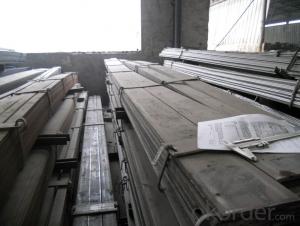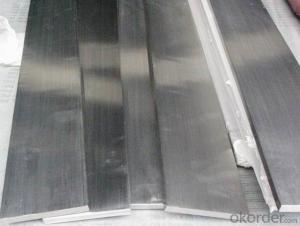high quality low carbon JIS steel flat bar
- Loading Port:
- Tianjin
- Payment Terms:
- TT OR LC
- Min Order Qty:
- 5 m.t.
- Supply Capability:
- 1000 m.t./month
OKorder Service Pledge
OKorder Financial Service
You Might Also Like
Product Description:
Specification of Mild Steel Flat Bar
Commodity: Mild Steel Flat Bar
Standard: GB;JIS
Material: Q195-235;SS400
Brand name: FLATSPACE
Origin place: China
Thickness: 3mm-30mm
Width:20mm-200mm
Length: Max 12m
Certification: SGS/BV
Chemical composition of Q235
Alloy No | Grade | Element(%) | ||||
C
| Mn
| S
| P
| Si
| ||
Q235
|
B
|
0.12—0.20 |
0.3—0.7 |
≤0.045 |
≤0.045
|
≤0.3
|
Physical properties of Q235
Alloy No | Grade | Yielding strength point(Mpa) | Tensile strength (Mpa) | Elongation after fracture(%) | ||||||
Thickness (mm) | Thickness (mm) | |||||||||
≤16 | >16--40 | >40--60 | >60--100 | ≤16 | >16--40 | >40--60 | >60--100 | |||
≥ | ≥ | |||||||||
Q235 |
B |
235 |
225 |
215 |
205 |
375--500 |
26 |
25 |
24 |
23 |
Usage/Applications of Mild Steel Flat Bar
Widely used for construction, Machinery manufacturing, Iron tower steel structure, Shipbuilding; Steel grating, Staircase, Bridge, Viaduct, Railway spare parts, Boilers making etc.
Packaging & Delivery of Mild Steel Flat Bar
Packaging Details: The Mild Steel Flat Bars are packed in bundles and loaded in 20 feet/40 feet container, or shipped by bulk cargo ,also we can do as customer's requirements.
Delivery Details:30~45 days upon the receipt of buyer payment by T.T. or L/C.
Production Flow of Mild Steel Flat Bar
The Mild steel flat bar is made through three processes:
1.Feeding the material: Feeding the row material (the steel plate) to Slitting Line.
2.Slitting:The steel plate would be slitted into expected width by lengthways cutter.
3. Leveled and cutting: The plat bar would be ground into level by the grinder and then cut into required length
- Q:Can steel flat bars be used in the manufacturing of agricultural implements?
- Yes, steel flat bars can definitely be used in the manufacturing of agricultural implements. Steel flat bars are strong, durable, and can be easily shaped and welded to create various components for agricultural machinery such as plows, cultivators, harrows, and seeders. They provide the necessary strength and stability required for heavy-duty farming equipment, making them a suitable choice for agricultural implement manufacturing.
- Q:How do you determine the strength of a steel flat bar?
- There are several methods available for determining the strength of a steel flat bar. One commonly used approach is through tensile testing, which involves applying a pulling force on a specimen until it fractures. This test allows for the measurement of load, deformation, stress, and strain, which can then be used to calculate various mechanical properties such as yield strength, ultimate tensile strength, and elongation. Another method to assess the strength of a steel flat bar is through hardness testing. Hardness is a measure of the material's resistance to indentation or scratching, and it is often indicative of its overall strength. Popular hardness tests for steel include Brinell, Rockwell, and Vickers tests. Furthermore, the strength of a steel flat bar can also be determined by considering its chemical composition. Steel is primarily composed of iron and carbon, but other elements like manganese, chromium, and nickel are added to enhance specific properties. The composition and heat treatment of the steel can greatly influence its strength. It is worth noting that the bending properties of a steel flat bar, such as flexural strength, can also be assessed through tests like the three-point bending test or the four-point bending test. These tests determine the maximum load a specimen can withstand before breaking or yielding under bending forces. In summary, the strength of a steel flat bar can be determined using methods such as tensile testing, hardness testing, considering its chemical composition, and analyzing its bending properties. These approaches provide valuable insights into the steel's mechanical properties, enabling engineers and manufacturers to choose the most suitable steel grade for specific applications.
- Q:Can steel flat bars be used in architectural applications?
- Certainly, architectural applications do make use of steel flat bars. These bars possess versatility and durability, rendering them appropriate for a range of architectural purposes. They find utility in constructing structural components like beams, columns, and braces, bestowing stability and fortitude upon buildings. Furthermore, steel flat bars can confer an ornamental touch, serving as handrails, balustrades, and cladding, infusing architectural designs with a contemporary and polished appearance. With their exceptional tensile strength and resistance to corrosion, architects can rely on steel flat bars as a trustworthy option that harmonizes functionality and aesthetics in their projects.
- Q:How do steel flat bars compare to other forms of steel like angles or channels?
- Steel flat bars, angles, and channels are all versatile and commonly used forms of steel. However, they differ in terms of their structural characteristics and applications. Steel flat bars are typically rectangular in shape with a flat surface, making them ideal for structural support, framing, and industrial applications where a flat surface is required. On the other hand, steel angles have an L-shaped cross-section, providing superior strength and stability, making them suitable for construction projects, bracing, and framework. Steel channels, with a U-shaped cross-section, offer excellent load-bearing capabilities, making them popular for applications such as beams, supports, and vehicle frames. Ultimately, the choice between these forms of steel depends on the specific requirements of the project at hand.
- Q:The minus sign in front of what 40 galvanized flat steel
- In front of a small cross is not a minus sign, but on behalf of the flat symbol. For example, the meaning of "-40*4" galvanized flat steel is: 40 is the width of the section steel, 4 is the thickness of the steel, and the unit is mm.
- Q:Can steel flat bars be used for making signage?
- Yes, steel flat bars can be used for making signage. They are a durable material that can withstand outdoor conditions and provide a sturdy base for mounting signs.
- Q:Are steel flat bars suitable for architectural detailing?
- Yes, steel flat bars are suitable for architectural detailing. They offer strength, durability, and versatility, making them ideal for various architectural applications such as handrails, window frames, door frames, and decorative elements. Additionally, steel flat bars can be easily manipulated and shaped to meet specific design requirements, providing architects with flexibility in their creative vision.
- Q:Can steel flat bars be used for making brackets or supports for power generation equipment?
- Yes, steel flat bars can definitely be used for making brackets or supports for power generation equipment. Steel is a robust and durable material that is commonly used in the construction of various industrial equipment, including power generation systems. Steel flat bars offer high strength and rigidity, making them suitable for supporting heavy loads and withstanding the demanding operating conditions often found in power generation facilities. Additionally, steel is known for its resistance to corrosion, which is essential for equipment that is exposed to moisture or harsh environments. Overall, steel flat bars are a reliable choice for fabricating brackets or supports for power generation equipment due to their strength, durability, and corrosion resistance.
- Q:What is the difference between steel band and steel ring? The steel strip is flat steel and the steel ring is made of steel. Am I right?
- Steel rolls are also called steel belts. There is no difference between them. They are not flat steel
- Q:How do you determine the tensile strength of a steel flat bar?
- The tensile strength of a steel flat bar can be determined through a destructive testing method called tensile testing. In this process, a sample of the steel flat bar is subjected to a gradually increasing tensile force until it reaches its breaking point. The force required to break the sample is then recorded, and this value represents the tensile strength of the steel flat bar.
1. Manufacturer Overview |
|
|---|---|
| Location | |
| Year Established | |
| Annual Output Value | |
| Main Markets | |
| Company Certifications | |
2. Manufacturer Certificates |
|
|---|---|
| a) Certification Name | |
| Range | |
| Reference | |
| Validity Period | |
3. Manufacturer Capability |
|
|---|---|
| a)Trade Capacity | |
| Nearest Port | |
| Export Percentage | |
| No.of Employees in Trade Department | |
| Language Spoken: | |
| b)Factory Information | |
| Factory Size: | |
| No. of Production Lines | |
| Contract Manufacturing | |
| Product Price Range | |
Send your message to us
high quality low carbon JIS steel flat bar
- Loading Port:
- Tianjin
- Payment Terms:
- TT OR LC
- Min Order Qty:
- 5 m.t.
- Supply Capability:
- 1000 m.t./month
OKorder Service Pledge
OKorder Financial Service
Similar products
New products
Hot products
Related keywords






























